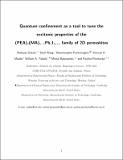Tuning the Excitonic Properties of the 2D (PEA) 2 (MA) n −1 Pb n I 3 n +1 Perovskite Family via Quantum Confinement
Author(s)
Dyksik, Mateusz; Wang, Shuli; Paritmongkol, Watcharaphol; Maude, Duncan K; Tisdale, William A; Baranowski, Michal; Plochocka, Paulina; ... Show more Show less
DownloadAccepted version (859.8Kb)
Open Access Policy
Open Access Policy
Creative Commons Attribution-Noncommercial-Share Alike
Terms of use
Metadata
Show full item recordAbstract
© 2021 American Chemical Society. In atomically thin two-dimensional (2D) crystals, the excitonic properties and band structure scale strongly with the thickness, providing a new playground for the investigation of exciton physics in the ultimate confinement regime. Here, we demonstrate the evolution of the fundamental excitonic properties, such as reduced mass, wave function extension, and exciton binding energy, in the 2D perovskite (PEA)2(MA)n-1PbnI3n+1, for n = 1, 2, 3. These parameters are experimentally determined using optical spectroscopy in a high magnetic field up to 65 T. The observation of the interband Landau level transitions provides direct access to the reduced effective mass μ and band gap Eg. We show that μ increases with the number of inorganic sheets n, reaching the value of three-dimensional (3D) MAPbI3 already for n = 3. Our experimental observations contradict the general expectation that quantum confinement leads to an enhanced carrier mass, showing another aspect of the unprecedented flexibility in the design of the electronic properties of 2D perovskites.
Date issued
2021Department
Massachusetts Institute of Technology. Department of Chemical Engineering; Massachusetts Institute of Technology. Department of ChemistryJournal
Journal of Physical Chemistry Letters
Publisher
American Chemical Society (ACS)